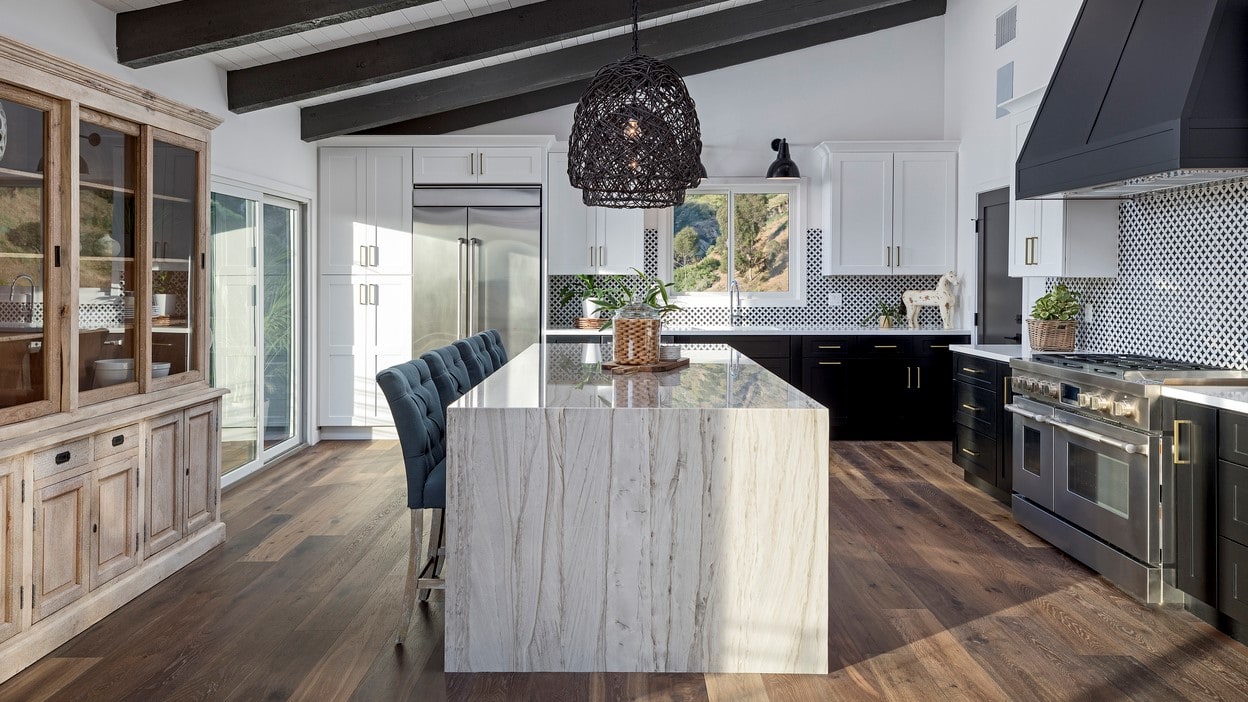Choosing the right flooring for your kitchen is crucial, as it needs to withstand heavy foot traffic, spills, and frequent cleaning. When it comes to kitchen flooring options, vinyl, and laminate are two popular choices. Let’s explore the features of each to help you make an informed decision.
Vinyl flooring is known for its durability, water resistance, and affordability. It is available in a wide range of styles, colors, and patterns, including options that mimic the look of natural materials like wood or stone. Vinyl flooring is relatively easy to install, and some types come in convenient peel-and-stick formats that make DIY installation a feasible option.
One of the advantages of vinyl flooring in the kitchen is its ability to resist water and moisture. This makes it a practical choice for areas prone to spills or high humidity. Vinyl floors are easy to clean, requiring only regular sweeping or mopping with a mild detergent solution.
On the other hand, laminate flooring is a synthetic material composed of multiple layers. It can closely resemble the appearance of hardwood or stone flooring at a more affordable price point. Laminate is known for its durability and resistance to scratches, making it a suitable option for kitchens with high foot traffic and active households.
Laminate flooring is relatively easy to install, often utilizing a click-lock system for a floating floor installation. However, it is important to note that laminate is not as water-resistant as vinyl. While it can handle occasional spills if cleaned up promptly, prolonged exposure to water can cause damage, swelling, or warping. Therefore, it’s important to wipe up spills promptly and avoid excessive moisture on laminate floors.
In terms of maintenance, both vinyl and laminate flooring are relatively low maintenance. Regular sweeping or vacuuming and occasional damp mopping should keep them clean and in good condition. It’s important to avoid harsh abrasives or cleaners that can damage the flooring’s surface.

When making a decision between vinyl and laminate flooring for your kitchen, consider your priorities. If water resistance and ease of maintenance are paramount, vinyl flooring may be the better choice. However, if you prefer the appearance of natural materials and are willing to take extra precautions to prevent water damage, laminate flooring can be a stylish and cost-effective option.
Ultimately, the decision between vinyl and laminate flooring for your kitchen comes down to your personal preferences, budget, and the specific needs of your household. Take the time to compare the features and weigh the pros and cons of each option before making your final decision.
LifeProof Luxury Vinyl Plank Flooring

5 reasons to choose vinyl flooring for your kitchen Urban Surfaces

Vinyl vs. Laminate Flooring: Pros, Cons And Differences u2013 Forbes

Vinyl Flooring – The Home Depot

10 Kitchens With Vinyl Plank
Difference Between Laminate and Vinyl Flooring HGTV

Related articles:
- Best Way To Seal Concrete Basement Floor
- Cork Flooring For Basement Pros And Cons
- Exercise Flooring For Basement
- Good Basement Flooring Options
- Best Flooring For A Basement Bathroom
- Crumbling Concrete Basement Floor
- Concrete Basement Floor Covering
- Diagram Of Basement Floor Drain
- Pouring Basement Floor After Framing
- Painting Basement Walls And Floors
Choosing between kitchen floor vinyl or laminate can be a daunting task for many homeowners. With so many options available, it can be hard to decide which flooring material is the best choice for your kitchen. Both vinyl and laminate flooring offer a variety of benefits, from easy installation to an affordable price tag. To help you make the right decision for your home, we’ve put together this comprehensive guide to kitchen floor vinyl or laminate.
What are the Differences Between Kitchen Floor Vinyl and Laminate?
The biggest difference between kitchen floor vinyl and laminate is the materials used to create them. Vinyl flooring is made from a PVC (polyvinyl chloride) material that is waterproof and durable. Laminate flooring, on the other hand, is made from layers of wood or fiberboard that are held together by a resin-like substance.
Which is Better for Kitchens: Vinyl or Laminate?
When deciding between kitchen floor vinyl and laminate, there are several factors to consider. If you’re looking for a low-maintenance option that won’t break the bank, then vinyl is the way to go. Vinyl is easy to install, water-resistant, and affordable. Laminate, on the other hand, is more expensive but offers a higher-end look and feel that can add value to your home. Both materials are long-lasting and durable, so they are suitable for busy kitchens.
What Are the Pros and Cons of Kitchen Floor Vinyl?
Pros:
– Vinyl kitchen floors are easy to install and require minimal maintenance.
– They are water resistant and can withstand spills and splashes.
– Vinyl floors come in a variety of colors and styles to match any décor.
– They are an affordable option for those on a budget.
Cons:
– Vinyl floors can be slippery when wet.
– They can be damaged by sharp objects and heavy furniture.
– They may fade over time due to direct sunlight exposure.
What Are the Pros and Cons of Kitchen Floor Laminate?
Pros:
– Laminate kitchen floors are available in a wide range of colors and styles, allowing you to customize your look.
– They are very durable and can withstand heavy foot traffic without showing signs of wear.
– Laminate floors are easy to clean and maintain with regular vacuuming and mopping.
Cons:
– Laminate floors can be expensive compared to vinyl floors.
– They may not be as waterproof as vinyl floors, so spills must be cleaned up quickly.
– Laminate floors may dent or scratch easily if not properly maintained.
Overall, choosing between kitchen floor vinyl or laminate is a personal decision that depends on your lifestyle, budget, and design preferences. Both materials offer their own unique advantages, so it’s important to weigh all your options before making a final decision.
